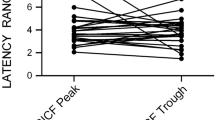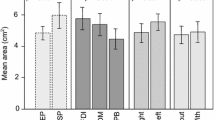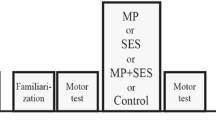Abstract
The purpose of this study was to further develop methods to assess corticospinal divergence and muscle coupling using transcranial magnetic stimulation (TMS). Ten healthy right-handed adults participated (7 females, age 34.0 ± 12.9 years). Monophasic single pulses were delivered to 14 sites over the right primary motor cortex at 40, 60, 80 and 100% of maximum stimulator output (MSO), using MRI-based neuronavigation. Motor evoked potentials (MEPs) were recorded simultaneously from 9 muscles of the contralateral hand, wrist and arm. For each intensity, corticospinal divergence was quantified by the average number of muscles that responded to TMS per cortical site, coactivation across muscle pairs as reflected by overlap of cortical representations, and correlation of MEP amplitudes across muscle pairs. TMS to each muscle’s most responsive site elicited submaximal MEPs in most other muscles. The number of responsive muscles per cortical site and the extent of coactivation increased with increasing intensity (ANOVA, p < 0.001). In contrast, correlations of MEP amplitudes did not differ across the 60, 80 and 100% MSO intensities (ANOVA, p = 0.34), but did differ across muscle pairs (ANOVA, p < 0.001). Post hoc analysis identified 4 sets of muscle pairs (Tukey homogenous subsets, p < 0.05). Correlations were highest for pairs involving two hand muscles and lowest for pairs that included an upper arm muscle. Correlation of MEP amplitudes may quantify varying levels of muscle coupling. In future studies, this approach may be a biomarker to reveal altered coupling induced by neural injury, neural repair and/or motor learning.








Similar content being viewed by others
Data availability
The datasets generated during and/or analyzed during the current study are available from the corresponding author on reasonable request.
References
Ahdab R, Ayache SS, Brugieres P, Farhat WH, Lefaucheur JP (2016) The hand motor hotspot is not always located in the hand knob: a Neuronavigated Transcranial Magnetic Stimulation Study. Brain Topogr 29:590–597. https://doi.org/10.1007/s10548-016-0486-2
Amassian VE, Cracco RQ, Maccabee PJ, Cracco JB, Henry K (1995) Some positive effects of transcranial magnetic stimulation. Adv Neurol 67:79–106
Barchiesi G, Cattaneo L (2013) Early and late motor responses to action observation. Soc Cogn Affect Neurosci 8:711–719. https://doi.org/10.1093/scan/nss049
Bembenek JP, Kurczych K, Karli Nski M, Czlonkowska A (2012) The prognostic value of motor-evoked potentials in motor recovery and functional outcome after stroke—a systematic review of the literature. Funct Neurol 27:79–84
Bizzi E, Cheung VC (2013) The neural origin of muscle synergies. Front Comput Neurosci 7:51. https://doi.org/10.3389/fncom.2013.00051
Bizzi E, Cheung VC, d’Avella A, Saltiel P, Tresch M (2008) Combining modules for movement. Brain Res Rev 57:125–133. https://doi.org/10.1016/j.brainresrev.2007.08.004
Buick AR, Kennedy NC, Carson RG (2016) Characteristics of corticospinal projections to the intrinsic hand muscles in skilled harpists. Neurosci Lett 612:87–91. https://doi.org/10.1016/j.neulet.2015.11.046
Byrnes ML, Thickbroom GW, Phillips BA, Mastaglia FL (2001) Long-term changes in motor cortical organisation after recovery from subcortical stroke. Brain Res 889:278–287. https://doi.org/10.1016/s0006-8993(00)03089-4
Capaday C (2004) The integrated nature of motor cortical function. Neuroscientist 10:207–220. https://doi.org/10.1177/107385403262109
Card NS, Gharbawie OA (2020) Principles of intrinsic motor cortex connectivity in primates. J Neurosci 40:4348–4362. https://doi.org/10.1523/JNEUROSCI.0003-20.2020
Cattaneo L (2018) Fancies and fallacies of spatial sampling with transcranial magnetic stimulation (TMS). Front Psychol 9:1171. https://doi.org/10.3389/fpsyg.2018.01171
Cheney PD, Fetz EE (1985) Comparable patterns of muscle facilitation evoked by individual corticomotoneuronal (CM) cells and by single intracortical microstimuli in primates: evidence for functional groups of CM cells. J Neurophysiol 53:786–804. https://doi.org/10.1152/jn.1985.53.3.786
Devanne H, Cohen LG, Kouchtir-Devanne N, Capaday C (2002) Integrated motor cortical control of task-related muscles during pointing in humans. J Neurophysiol 87:3006–3017. https://doi.org/10.1152/jn.2002.87.6.3006
Devanne H, Cassim F, Ethier C, Brizzi L, Thevenon A, Capaday C (2006) The comparable size and overlapping nature of upper limb distal and proximal muscle representations in the human motor cortex. Eur J Neurosci 23:2467–2476. https://doi.org/10.1111/j.1460-9568.2006.04760.x
Dewald JP, Pope PS, Given JD, Buchanan TS, Rymer WZ (1995) Abnormal muscle coactivation patterns during isometric torque generation at the elbow and shoulder in hemiparetic subjects. Brain 118(Pt 2):495–510. https://doi.org/10.1093/brain/118.2.495
Ellis MD, Kottink AI, Prange GB, Rietman JS, Buurke JH, Dewald JP (2011) Quantifying loss of independent joint control in acute stroke with a robotic evaluation of reaching workspace. Conf Proc IEEE Eng Med Biol Soc 2011:8231–8234. https://doi.org/10.1109/IEMBS.2011.6091940
Ethier C, Brizzi L, Darling WG, Capaday C (2006) Linear summation of cat motor cortex outputs. J Neurosci 26:5574–5581. https://doi.org/10.1523/JNEUROSCI.5332-05.2006
Ferrier D (1873) Experimental researches in cerebral physiology and pathology. J Anat Physiol 8:152–155
Fritsch G, Hitzig E (1870) Electric excitability of the cerebrum (Uber die elektrische Erregbarkeit des Grosshirns). Arch Anat Physiol Wissen 37:300–332. https://doi.org/10.1016/j.yebeh.2009.03.001
Gentner R, Classen J (2006) Modular organization of finger movements by the human central nervous system. Neuron 52:731–742. https://doi.org/10.1016/j.neuron.2006.09.038
Groppa S, Oliviero A, Eisen A et al (2012) A practical guide to diagnostic transcranial magnetic stimulation: report of an IFCN committee. Clin Neurophysiol 123:858–882. https://doi.org/10.1016/j.clinph.2012.01.010
Huntley GW, Jones EG (1991) Relationship of intrinsic connections to forelimb movement representations in monkey motor cortex: a correlative anatomic and physiological study. J Neurophysiol 66:390–413. https://doi.org/10.1152/jn.1991.66.2.390
Kallioniemi E, Julkunen P (2016) Alternative stimulation intensities for mapping cortical motor area with navigated TMS. Brain Topogr 29:395–404. https://doi.org/10.1007/s10548-016-0470-x
Kleim JA, Kleim ED, Cramer SC (2007) Systematic assessment of training-induced changes in corticospinal output to hand using frameless stereotaxic transcranial magnetic stimulation. Nat Protoc 2:1675–1684. https://doi.org/10.1038/nprot.2007.206
Marconi B, Pecchioli C, Koch G, Caltagirone C (2007) Functional overlap between hand and forearm motor cortical representations during motor cognitive tasks. Clin Neurophysiol 118:1767–1775. https://doi.org/10.1016/j.clinph.2007.04.028
Masse-Alarie H, Bergin MJG, Schneider C, Schabrun S, Hodges PW (2017) “Discrete peaks” of excitability and map overlap reveal task-specific organization of primary motor cortex for control of human forearm muscles. Hum Brain Mapp 38:6118–6132. https://doi.org/10.1002/hbm.23816
Mathew J, Kubler A, Bauer R, Gharabaghi A (2016) Probing corticospinal recruitment patterns and functional synergies with transcranial magnetic stimulation. Front Cell Neurosci 10:175. https://doi.org/10.3389/fncel.2016.00175
McMorland AJ, Runnalls KD, Byblow WD (2015) A neuroanatomical framework for upper limb synergies after stroke. Front Hum Neurosci 9:82. https://doi.org/10.3389/fnhum.2015.00082
Melgari JM, Pasqualetti P, Pauri F, Rossini PM (2008) Muscles in “concert”: study of primary motor cortex upper limb functional topography. PLoS ONE 3:e3069. https://doi.org/10.1371/journal.pone.0003069
Neptune RR, Clark DJ, Kautz SA (2009) Modular control of human walking: a simulation study. J Biomech 42:1282–1287. https://doi.org/10.1016/j.jbiomech.2009.03.009
Nudo RJ, Milliken GW, Jenkins WM, Merzenich MM (1996) Use-dependent alterations of movement representations in primary motor cortex of adult squirrel monkeys. J Neurosci 16:785–807
Omrani M, Kaufman MT, Hatsopoulos NG, Cheney PD (2017) Perspectives on classical controversies about the motor cortex. J Neurophysiol 118:1828–1848. https://doi.org/10.1152/jn.00795.2016
Overduin SA, d’Avella A, Roh J, Carmena JM, Bizzi E (2015) Representation of muscle synergies in the primate brain. J Neurosci 35:12615–12624. https://doi.org/10.1523/JNEUROSCI.4302-14.2015
Penfield W, Rasmussen T (1950) The cerebral cortex of man. MacMillan, New York
Raffin E, Pellegrino G, Di Lazzaro V, Thielscher A, Siebner HR (2015) Bringing transcranial mapping into shape: sulcus-aligned mapping captures motor somatotopy in human primary motor hand area. Neuroimage 120:164–175. https://doi.org/10.1016/j.neuroimage.2015.07.024
Rana M, Yani MS, Asavasopon S, Fisher BE, Kutch JJ (2015) Brain connectivity associated with muscle synergies in humans. J Neurosci 35:14708–14716. https://doi.org/10.1523/JNEUROSCI.1971-15.2015
Roh J, Rymer WZ, Beer RF (2012) Robustness of muscle synergies underlying three-dimensional force generation at the hand in healthy humans. J Neurophysiol 107:2123–2142. https://doi.org/10.1152/jn.00173.2011
Rosenkranz K, Williamon A, Rothwell JC (2007) Motorcortical excitability and synaptic plasticity is enhanced in professional musicians. J Neurosci 27:5200–5206. https://doi.org/10.1523/JNEUROSCI.0836-07.2007
Rossi S, Hallett M, Rossini PM, Pascual-Leone A (2011) Screening questionnaire before TMS: an update. Clin Neurophysiol 122:1686. https://doi.org/10.1016/j.clinph.2010.12.037
Safavynia SA, Torres-Oviedo G, Ting LH (2011) Muscle synergies: implications for clinical evaluation and rehabilitation of movement. Top Spinal Cord Inj Rehabil 17:16–24. https://doi.org/10.1310/sci1701-16
Sanes JN, Schieber MH (2001) Orderly somatotopy in primary motor cortex: does it exist? Neuroimage 13:968–974. https://doi.org/10.1006/nimg.2000.0733
Schieber MH, Hibbard LS (1993) How somatotopic is the motor cortex hand area? Science 261:489–492. https://doi.org/10.1126/science.8332915
Schneider C, Zytnicki D, Capaday C (2001) Quantitative evidence for multiple widespread representations of individual muscles in the cat motor cortex. Neurosci Lett 310:183–187. https://doi.org/10.1016/s0304-3940(01)02105-x
Shinoda Y, Yokota J, Futami T (1981) Divergent projection of individual corticospinal axons to motoneurons of multiple muscles in the monkey. Neurosci Lett 23:7–12. https://doi.org/10.1016/0304-3940(81)90182-8
Thickbroom GW, Sammut R, Mastaglia FL (1998) Magnetic stimulation mapping of motor cortex: factors contributing to map area. Electroencephalogr Clin Neurophysiol 109:79–84
Thickbroom GW, Byrnes ML, Archer SA, Mastaglia FL (2004) Motor outcome after subcortical stroke correlates with the degree of cortical reorganization. Clin Neurophysiol 115:2144–2150. https://doi.org/10.1016/j.clinph.2004.04.001
Torres-Oviedo G, Ting LH (2010) Subject-specific muscle synergies in human balance control are consistent across different biomechanical contexts. J Neurophysiol 103:3084–3098. https://doi.org/10.1152/jn.00960.2009
Trompetto C, Assini A, Buccolieri A, Marchese R, Abbruzzese G (2000) Motor recovery following stroke: a transcranial magnetic stimulation study. Clin Neurophysiol 111:1860–1867
Tyc F, Boyadjian A, Devanne H (2005) Motor cortex plasticity induced by extensive training revealed by transcranial magnetic stimulation in human. Eur J Neurosci 21:259–266. https://doi.org/10.1111/j.1460-9568.2004.03835.x
Tyc F, Boyadjian A, Allam N, Brasil-Neto JP (2012) Abnormal acute changes in upper limb muscle cortical representation areas in the patients with writer’s cramp during co-activation of distal and proximal muscles. Acta Physiol (Oxf) 206:195–207. https://doi.org/10.1111/j.1748-1716.2012.02451.x
van de Ruit M, Grey MJ (2016) The TMS map scales with increased stimulation intensity and muscle activation. Brain Topogr 29:56–66. https://doi.org/10.1007/s10548-015-0447-1
Vigano L, Fornia L, Rossi M et al (2019) Anatomo-functional characterisation of the human “hand-knob”: a direct electrophysiological study. Cortex 113:239–254. https://doi.org/10.1016/j.cortex.2018.12.011
Wassermann EM, McShane LM, Hallett M, Cohen LG (1992) Noninvasive mapping of muscle representations in human motor cortex. Electroencephalogr Clin Neurophysiol 85:1–8. https://doi.org/10.1016/0168-5597(92)90094-r
Wilson SA, Thickbroom GW, Mastaglia FL (1993) Transcranial magnetic stimulation mapping of the motor cortex in normal subjects. The representation of two intrinsic hand muscles. J Neurol Sci 118:134–144. https://doi.org/10.1016/0022-510x(93)90102-5
Yousry TA, Schmid UD, Alkadhi H, Schmidt D, Peraud A, Buettner A, Winkler P (1997) Localization of the motor hand area to a knob on the precentral gyrus. A new landmark. Brain 120(Pt 1):141–157. https://doi.org/10.1093/brain/120.1.141
Acknowledgements
This work was funded by the Comprehensive Opportunities for Rehabilitation Research Training (CORRT), a Multicenter Career Development Program for Physical and Occupational Therapists, National Institutes of Health Grant Number K12 HD055931, the University of Iowa Carver College of Medicine and the Department of Physical Therapy and Rehabilitation Science. MR scans were conducted on an MRI instrument funded by NIH 1S10OD025025-01. The authors acknowledge Lauren Werner for assistance with data collection.
Author information
Authors and Affiliations
Corresponding author
Ethics declarations
Conflict of interest
The authors declare that they have no conflict of interest.
Ethical Approval
All procedures were in accordance with the ethical standards of the University of Iowa Human Subjects Institutional Review Board and with the 1964 Helsinki declaration and its later amendments.
Additional information
Handling Editor: Giacomo Koch.
Publisher's Note
Springer Nature remains neutral with regard to jurisdictional claims in published maps and institutional affiliations.
Rights and permissions
About this article
Cite this article
DeJong, S.L., Bisson, J.A., Darling, W.G. et al. Simultaneous Recording of Motor Evoked Potentials in Hand, Wrist and Arm Muscles to Assess Corticospinal Divergence. Brain Topogr 34, 415–429 (2021). https://doi.org/10.1007/s10548-021-00845-1
Received:
Accepted:
Published:
Issue Date:
DOI: https://doi.org/10.1007/s10548-021-00845-1




